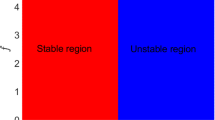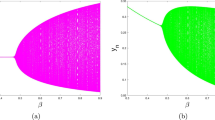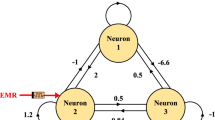Abstract
Purpose
In this paper, we present a fitted model of the extended Hindmarsh–Rose (eHR) neuron constructed using the hyperbolic tangent composite functions to replace the non-linear polynomial functions present in the original model of the eHR neuron.
Methods
Thus, through classical techniques of analysis of nonlinear systems, we observe complex phenomena generated by this system when the excitation current varies. In addition, a variation of the bifurcation parameters allows us to see that the adjusted model of the neuron eHR is sensitive to the initial conditions, and therefore exhibits the multistability, which is produced by the phenomenon of parallel branches or hysteresis in this system. To control these coexistences of attractors, a control method based on the feedback term is applied to the model.
Results
We see that the addition of this space-dependent feedback term to the dynamic equation of this model drives the dynamic towards the desired attractor by annihilating the other. This powerful technique makes it possible to move from a multistable system to a monostable system.
Conclusion
Finally, we propose an on-board system implementation of this neural circuit using microcontroller technology. This constitutes an important and reliable tool which can best mimic biological neurons.














Similar content being viewed by others
References
Abraham RH, Stewart HB (1986) A chaotic blue sky catastrophe in forced relaxation oscillations. Phys D 21:394–400
Aram Z, Jafari S, Ma J, Sprott JC, Zendehrouh S, Pham VT (2017) Using chaotic artificial neural networks to model memory in the brain. Commun Nonlinear Sci Numer Simul 44:449–59
Bao BC, Yang QF, Zhu L, Bao H, Xu Q, Yu YJ, Chen M (2019) Chaotic bursting dynamics and coexisting multistable firing patterns in 3D autonomous Morris-Lecar model and microcontroller-based validations. Int. J. Bifurc Chaos 29:1950134
Bao BC, Zhu Y, Li CQ, Bao H, Xu Q (2020) Global multistability and analog circuit implementation of an adapting synapse-based neuron model. Nonlinear Dyn 101:1105–1118
Bao BC, Zhu YX, Ma J (2021) Memristive neuron model with an adapting synapse and its hardware experiments. Sci China Tech Sci 64(5):1107–1117. https://doi.org/10.1007/s11431-020-1730-0
Borgers C (2017) An introduction to modeling neuronal dynamics. Springer International Publishing, p 17
De Lange E, Hasler M (2008) Predicting single spikes and spike patterns with the Hindmarsh-Rose model. Biol Cybern 99:349–60
Gonzalez-Miranda JM (2003) Observation of a continuous interior crisis in the Hindmarsh-Rose neuron model. Chaos 13:825–45
Gonzalez-Miranda JM (2007) Complex bifurcation structures in the Hindmarsh-Rose model. Int J Bifurc Chaos 17:3071–83
Grebogi C, Ott E, Yoke JA (1983) Crises, sudden changes in chaotic attractors and transient chaos. Phys D 7:181–200
Grebogi C, Ott E, Romeiras F, Yoke JA (1987) Critical exponents for crisis induced intermittency. Phys Rev A 36:5365–80
Grebogi C, Ott E, Yorke JA (1987) Chaos, strange attractors and fractal basin boundaries in nonlinear dynamics. Sci New Ser 238:632–8
Gu HG, Pan BB, Chen GR, Duan LX (2014) Biological experimental demonstration of bifurcations from bursting to spiking predicted by theoretical models. Nonlinear Dyn 78:391–407
Heidarpur M, Ahmadi A, Ahmadi M, Azghadi MR (2019) CORDIC- SNN: On-FPGA STDP learning with Izhikevich neurons. IEEE Trans Circ Syst I Reg Papers 66:2651–2661
Herz AVM, Gollisch T, Machens CK, Jaeger D (2006)Modeling single-neuron dynamics and computations: a balance of detail and abstraction. Sci 314:80
Heyward P, Ennis M, Keller A, Shipley MT (2001) Membrane bistability in olfactory bulb mitral cells. J Neurosci 21:5311–20
Hindmarsh JL, Rose RM (1982) A model of the nerve impulse using two first-order differential equations. Nature 296:162–164
Hindmarsh JL, Rose RM (1984) A model of neuronal bursting using three coupled first order differential equations. Proc R Soc Lond B Biol Sci 221:87–102
Hodgkin AL, Huxley AF (1952) Propagation of electrical signals along giant nerve fibres. J Physiol Lond 117:500
Hounsgaard J, Kiehn O (1989) Serotonin-induced bistability of turtle motoneurones caused by a nifedipine-sensitive calcium plateau potential. J Physiol 414:265–82
Hu X, Liu C, Liu NJ, Li S (2016) An electronic implementation for Morris-Lecar neuron model. Nonlinear Dyn 84:2317–2332
Hu X, Feng G, Duan SK, Liu L (2017) A memristive multilayer cellular neural network with applications to image processing. IEEE Trans Neural Netw Learn Syst 28:1889–1901
Jiang YN, Huang P, Zhu DB, Han RZ, Liu LF, Liu XY, Kang JF (2019) Design and hardware implementation of neuromorphic systems with RRAM synapses and threshold controlled neurons for pattern recognition. IEEE Trans Circ Syst I Reg Papers 65:2726–2738
Cai JM, Bao H, Xu Q, Hua ZY, Bao B (2021) Smooth nonlinear fitting scheme for analog multiplierless implementation of Hindmarsh-Rose neuron model. Nonlinear Dyn. https://doi.org/10.1007/s11071-021-06453-9
Jokar E, Soleimani H (2017) Digital multiplierless realization of a calcium-based plasticity model. IEEE Trans Circ Syst II Exp Briefs 64:832–836
Jokar E, Abolfathi H, Ahmadi A, Ahmadi M (2019) An efficient uniform-segmented neuron model for large-scale neuromorphic circuit design: simulation and FPGA synthesis results. IEEE Trans Circ Syst I Reg Papers 66:2336–2349
Kengne J, Chedjou JC, Kom M, Kyamakya K, Kamdoum VT (2014) Regular oscillations, chaos and multistability in a system of two coupled van der Pol oscillators numerical and experimental studies. Nonlinear Dyn 76:1119–32
Kengne J, Jafari S, Njitacke ZT, Yousefi AK, Cheukem A (2017) Dynamic analysis and electronic circuit implementation of a novel 3D autonomous system without linear terms. Commun Nonlinear Sci Numer Simul. https://doi.org/10.1016/j.cnsns.2017.04.017
Kiran Y, Neeraj KK, Manish DS (2017) Intermittent feedback induces attractor selection. Phys Rev E 95:042215
Kuznetsov YA (1998) Elements of applied bifurcation theory. Springer, New YorK
Lai Q, Norouzi B, Liu F (2018) Dynamic analysis, circuit realization, control design and image encryption application of an extended Lu system with coexisting attractors. Chaos Solitons Fractals 114:230–245
Lai Q, Wan Z, Kengne LK, Kuate PDK, Chen C (2021) Two-memristor-based chaotic system with infinite coexisting attractors. IEEE Trans Circ Syst II Express Briefs 68(6):2197–2201
Lai Q (2021) A unified chaotic system with various coexisting attractors. Int J Bifurc Chaos 31(1):2150013
Lai Q, Wan Z, Kengne LK, Kuate PDK (2020) Modeling and circuit realisation of a new no-equilibrium chaotic system with hidden attractor and coexisting attractors. Electron Lett 56(20):1044–1046
Lai Q, Wan Z, Kuate PDK, Fotsin H (2020) Coexisting attractors, circuit implementation and synchronization control of a new chaotic system evolved from the simplest memristor chaotic circuit. Commun Nonlinear Sci Numer Simul 89:105341
Larras B, Lahuec C, Seguin F, Arzel M (2016) Ultra-lowenergy mixed-signal IC implementing encoded neural networks. IEEE Trans Circ Syst I Reg Papers 63:1974–1985
Loewenstein Y, Mahon S, Chadderton P, Kitamura K, Sompolinsky h (2005) Bistability of cerebellar Purkinje cells modulated by sensory stimulation. Nat Neurosci 8:202–11
Ma J, Yang Z, Yang L et al (2019) Phase coupling synchronization of FHN neurons connected by a Josephson junction. J Zhejiang Univ Sci A 20:639
Maggio GM, De Feo O, Kennedy MP (1999) Nonlinear analysis of the Colpitts oscillator and application to design. IEEE Trans Circ Syst 46:1118–30
Malashchenko T, Shilnikov A, Cymbalyuk G (2011) Bistability of bursting and silence regimes in a model of a leech heart interneuron. Phys Rev E 84(1–8):041910
Marin B, Barnett WH, Doloc-Mihu A, Calabrese RL, Cymbalyuk GS (2013) High prevalence of multistability of rest states and bursting in a database of a model neuron. PLoS Comput Biol 9(1–12):E1002930
Masoller C (1994) Coexistence of attractors in a laser diode with optical feedback from a large external cavity. Phys Rev A 50:2569–78
Megam NEB, Fotsin HB, Louodop FP, Kamdoum TV, Hilda CA (2016) Bifurcations and multistability in the extended Hindmarsh-Rose neuronal oscillator. Chaos Solitons Fractals 85:151–63
Mondal A, Kumar Upadhyay R, Ma J, Yadav BK, Sharma SK (2017) Bifurcation analysis and diverse firing activities of a modified excitable neuron model. Cogn Neurodyn 13:393–407
Morris C, Lecar H (1981) Voltage oscillations in the barnacle giant muscle fiber. Biophys J 35:193–213
Nayfeh AH, Balachandran B (1995) Applied nonlinear dynamics analytical, computational, and experimental methods. Germany Wiley
Njitacke ZT, Kengne J, Fotsin HB (2018) A plethora of behaviors in a memristor based Hopfield neural networks (HNNs). Int J Dyn Control 7:36–52
Njitacke Z, Kengne J (2018) Complex dynamics of a 4D Hopfield neural networks (HNNs) with a nonlinear synaptic weight: coexistence of multiple attractors and remerging Feigenbaum trees. AEU-Int J Electron Commun 93:242–252
Njitacke ZT, Kengne J, Fonzin FT, Leutcha BP, Fotsin HB (2019) Dynamical analysis of a novel 4-neurons based Hopfield neural network: emergences of antimonotonicity and coexistence of multiple stable states. Int J Dyn Control 7:823
Njitacke ZT, Kengne J (2019) Nonlinear dynamics of three-neurons-based Hopfield neural networks (HNNs): remerging Feigenbaum trees, coexisting bifurcations and multiple attractors. J Circ Syst Comput 28:1950121
Njitacke ZT, Doubla IS, Mabekou S, Kengne J (2020) Hidden electrical activity of two neurons connected with an asymmetric electric coupling subject to electromagnetic induction: coexistence of patterns and its analog implementation. Chaos Solitons Fractals 137:109785
Njitacke ZT, Doubla IS, Kengne J, Cheukem A (2020) Coexistence of firing patterns and its control in two neurons coupled through an asymmetric electrical synapse. Chaos 30:023101
Njitacke ZT, Sone ME, Fozin TF, Tsafack N, Leutcho GD, Tchapga CT (2021) Control of multistability with selection of chaotic attractor: application to image encryption. Eur Phys J Spec Top 230(7):1839–1854
Noble D (1960) Cardiac action and pacemaker potentials based on the Hodgkin-Huxley equations. Nature 188:495
Panahi S, Aram Z, Jafari S, Ma J, Sprott JC (2017) Modeling of epilepsy based on chaotic artificial neural network. Chaos Solitons Fractals 105:150–6
Pastor-Diaz I, Perez-Garcia VM, Encinas-Sanz F, Gerra JM (1983) Ordered and chaotic behavior of two coupled van der Pol oscillators. Phys Rev E 48:171–82
Pastor-Diaz I, Lopez-Fragas A (1995) Dynamics of two coupled van der Pol oscillators. Phys Rev E 52:1480–9
Perrier JF, Hounsgaard J (2000) Development and regulation of response properties in spinal cord motoneurons. Brain Res Bull 53:529–35
Prakash P, Rajagopal K, Singh JP, Roy BK (2018) Megastability in a quasi-periodically forced system exhibiting multistability, quasi-periodic behaviour, and its analogue circuit simulation. AEU-Int J Electron Commun 92:111–115
Rahimian E, Zabihi S, Amiri M, Linares-Barranco B (2018) Digital implementation of the two-compartmental PinskyRinzel pyramidal neuron model. IEEE Trans Biomed Circ Syst 12:47–57
Selverston AI, Rabinovich MI, Abarbanel HDI, Elson R, Szucs A, Pinto RD et al (2000) Reliable circuits from irregular neurons: a dynamical approach to understanding central pattern generators. J Physiol 94:357–74
Shilnikov A, Cymbalyuk G (2005) Transition between tonic spiking and bursting in a neuron model via the blue-sky catastrophe. Phys Rev Lett 94(1–4):048101
Storace M, Linaro D, De Lange E (2008) The Hindmarsh–Rose neuron model: bifurcation analysis and piecewise-linear approximations. Chaos 18:033128
Tuna M, Karthikeyan A, Rajagopal K, Alcin M, Koyuncu I (2019) Hyperjerk multiscroll oscillators with megastability: analysis, FPGA implementation and a novel ANNring-based true random number generator. AEU-Int J Electron Commun 112:152941
Tapche RW, Njitacke ZT, Kengne J (2021) Complex dynamics of a novel 3D autonomous system without linear terms having line of equilibria: coexisting bifurcations and circuit design. FB Pelap Analog Integr Circ Signal Process 103(1):57–7
Vaithianathan V, Veijun J (1999) Coexistence of four different attractors in a fundamental power system model. IEEE Trans Circ Syst I 46:405–9
Wouapi KM, Fotsin HB, Feudjio KF, Njitacke ZT (2019) Hopf bifurcation, offset boosting and remerging Feigenbaum trees in an autonomous chaotic system with exponential nonlinearity. SN Appl Sci 1:1715
Wouapi KM, Fotsin H, Louodop FP, Feudjio KF, Njitacke TZ, Djeudjo TH (2020) Various firing activities and finite-time synchronization of an improved Hindmarsh-Rose neuron model under electric field effect. Cogn Neurodyn. https://doi.org/10.1007/s11571-020-09570-0
Xu Y, Jia Y, Ge MY, Lu LL, Yang LJ, Zhan X (2018) Effects of ion channel blocks on electrical activity of stochastic Hodgkin-Huxley neural network under electromagnetic induction. Neurocomputing 283:196–204
Zhang S, Cui K, Zhang X, Shi X, Ge M, Zhao M, Xu G, Yan W (2018) Effect of transcranial ultrasonic-magnetic stimulation on two types of neural firing behaviors in modified Izhikevich model. IEEE Trans Magn 54:5000204
Ying X, Yeye G, Guodong R, Jun M (2020) Dynamics and stochastic resonance in a thermosensitive neuron. Appl Math Comput 385:125427
Ying X, Minghua L, Zhigang Z, Jun M (2020) Dynamics and coherence resonance in a thermosensitive neuron driven by photocurrent. Chin Phys 29:098704
Yong L, Wan-jiang X, Jun M, Faris A, Aatef H (2020) A new photosensitive neuron model and its dynamics. Inf Technol Electron Eng Front. https://doi.org/10.1631/FITEE.1900606
Acknowledgements
Jules Tagne Fossi thanks the Faculty of Sciences of the University of Ngaoundéré for its important contribution. Zeric Tabekoueng Njitacke has been supported by the Polish National Science Centre under the Grant OPUS 14 No. 2017/27/B/ST8/01330.
Author information
Authors and Affiliations
Corresponding authors
Ethics declarations
Competing interest
The authors declare that they have no known competing financial interests or personal relationships that could have appeared to influence the work reported in this paper.
Additional information
Publisher's Note
Springer Nature remains neutral with regard to jurisdictional claims in published maps and institutional affiliations.
Rights and permissions
About this article
Cite this article
Fossi, J.T., Edima, H.C., Njitacke, Z.T. et al. Coexistence of Attractors and Its Control with Selection of a Desired Attractor in a Model of Extended Hindmarsh–Rose Neuron with Nonlinear Smooth Fitting Function: Microcontroller Implementation. J. Vib. Eng. Technol. 10, 2751–2764 (2022). https://doi.org/10.1007/s42417-022-00518-8
Received:
Revised:
Accepted:
Published:
Issue Date:
DOI: https://doi.org/10.1007/s42417-022-00518-8




